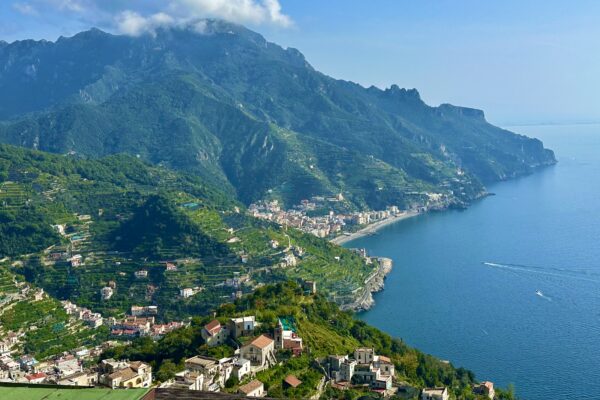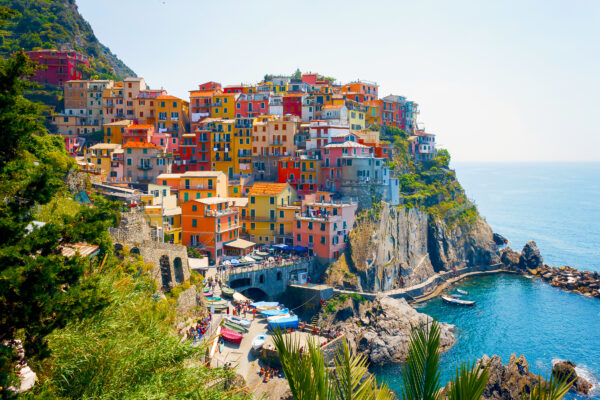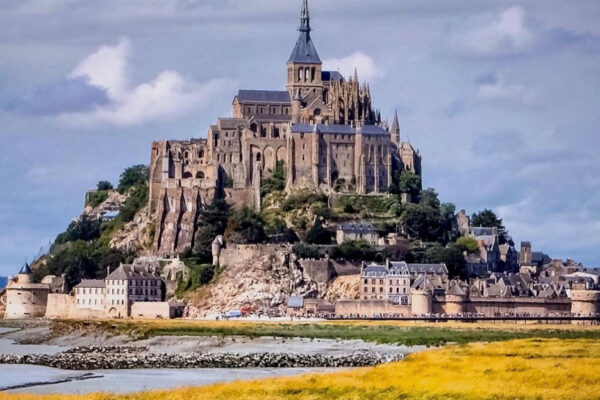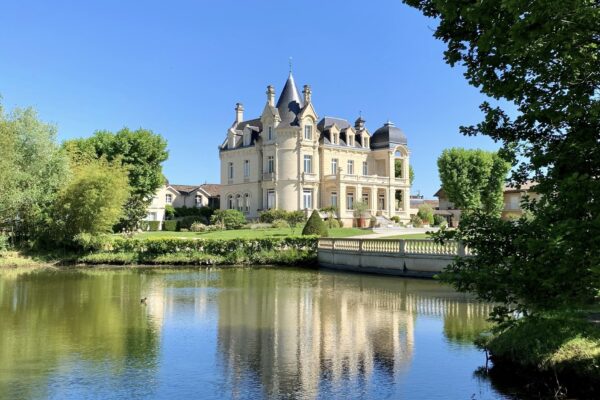Emilia-Romagna: Maranello & Modena

Central Modena and the Cattedrale Duomo
by Michel Thibault & Marla Norman
In Modena, you’ll find the Enzo Ferrari Museum where the racing legend’s life is documented. In Maranello, however is the Ferrari Museum, with race cars on display, a simulation room and numerous artifacts from the “old days.”
Maranello is a half-hour drive in the country from Modena. Parking for the Museum can be tough as there are always hordes of fans trying to get in. Hours differ from winter to summer, but if you get there on the early side, between 9:30 a.m. and 2:00 p.m. you’re good to go.

The Ferrari Museum: Fast cars, technology and a little romance. Photo by Marla Norman.
The first few rooms show off Ferrari technology, with an enormous engines on display. Then it’s on to the wildest cars, with creations from post 2000 — as in the Le Mans prototypes — followed by the 80s and 90s models which might remind you of the 80s and 90s Corvettes (not my favorite body style, but interesting nonetheless.)
After…..the romance is on, with the 60s coupes which remind you of the Riviera films starring Sophia Loren wearing her shades and head scarf. The cars are rich red of course, the color of the Pranzing Horse, Ferrari’s logo. Others are jet black and my favorite is a baby blue number I wanted to take home with me!!!

Michel admires the 1953 340 MM (Mille Miglia) in a dreamy shade of blue. Photo by Marla Norman.
Another room features about 15 cars that raced in Formula 1 throughout the years. The improved technology from those days to today is amazing. If you have not seen the movie “Grand Prix” directed by John Frankenheimer, watch it and marvel at the bravery of those racers driving sardine cans at 180 miles per hour. We all bemoan the modern world compared to the days of yore but I am reminded that 4-5 years ago, Romain Grosjean, a Formula One driver had a horrible accident: his car flew in the air, crashed at high speed on a retaining barrier, burst in flames and was cut in half — literally!! And yet, Romain was pulled out of the car with only a hand burn, although a serious injury. Thankfully, safety has improved dramatically.
Elsewhere in the exhibits, Phil Hill”s rudimentary helmet is a showpiece and there is a lot of space dedicated to the great champion, Michael Schumacher. Before you leave, try your hand driving the simulator or if you are embarrassed, let your kids do it. But don’t forget to stop by the gift shop (as I did) to get the must have Ferrari T-shirt or a jacket that will make you the envy of all your friends.

Michel with a Ferrari souvenir. Phto by Marla Norman.
ON TO MODENA
Needless to say, Michel and I are famished after racing around the Ferrari Museum, so lunch is a priority. Modena’s best-known restaurant is the 3-star Michelin Osteria Francescana, owned by chef-celebrity Massimo Bottura. Unfortunately, getting reservations is not so easy. So, our choice for the day is Trattoria Ermes. Known for “cucina casalinga” (Italian home cooking) a far stretch from Bottura’s elevated cuisine, Ermes is also a local legend, beloved in Modena for decades.
A tiny spot, Ermes takes no reservations and fills up quickly. We’re relieved to see that there are still a few tables left when we arrive. The charming host seats us and provides small printed menus, equal to the size of the restaurant. As we look over the daily specials, our host reappears with a generous plate of salumi and bread.

Coniglio al forno con patate with Lambrusco at Trattoria Ermes.
Michel glances at the wine list and optimistically announces: “Well…none of it will kill us. Let’s go with the Lambrusco.” Along with the wine, he orders Coniglio al forno con patate (Baked rabbit with potatoes) and I have the Tagliatelle al Ragù. Both dishes are hearty and delicious. The Lambrusco works and a chocolate torte to cap off the meal is luscious. The total for our lunch is as itty-bitty as Ermes itself, some 30€ with a complimentary Limoncello. Piuttosto buono!
DUOMO SANTA MARIA ASSUNTA E SAN GEMINIANO
Modena is filled with cute boutiques, gelaterias, vinotecas and balsamic vinegar shops (More on those later!) The city’s most distinctive landmark is La Torre Ghirlandina (Duomo bell tower), easy to spot from anywhere. We keep an eye on the tower to reach the Piazza Grande and the 12th century Duomo.

Colorful streets of Modena and La Torre Ghirlandina (Duomo bell tower). Photo by Marla Norman
The Duomo, formally known as Cattedrale Metropolitana di Santa Maria Assunta e San Geminiano, is striking for its architectural purity. Considered the finest Romanesque church in Italy, the Duomo is listed as a Unesco World Heritage Site. Built in 1099, the ancient structure has a brick interior dominated by a huge Gothic rose window — a 13th century addition.
Two mammoth sculpted lions support columns within one of the three naves. Interestingly, architects believe the beasts were created during the Roman era and later repurposed for the church. A sculpted marble relief by Anselmo da Campione portrays the Last Supper in vivid detail.

The interior of the Modena Duomo features sculpted lions possibly dating from the Roman era. Photo by Marla Norman.
Particularly noteworthy is the cathedral’s north portal, known as Porta della Pescheria. Carvings here, also dating from the 11th century, are of chivalric knights in armor and battle scenes that portray the Arthurian legend. Incredibly, many scholars believe the Modena Cathedral may be the earliest known reference to King Arthur, a figure who appears not only in English literature, but throughout European folklore.

Porta della Pescheria: Battle scenes portraying the Arthurian legend. Photo courtesy of Cattedrale di Modena.
The Duomo is spellbinding and we’re reluctant to re-enter the 21st century, but we have an appointment to taste balsamic vinegars — no missing that!

Aging barrels or “batterie” used to produced Balsamico di Modena. Photo by Mrla Norman.
BALSAMICO DI MODENA
The sweet and pungent aromas wafting through the doors of La Consorteria immediately stop us in our tracks. Once inside the shop, we are dazzled by a vast array of glass bottles and jars filling the shelves and spilling over onto tables.
La Consorteria is dedicated exclusively to Aceto Balsamico Tradizionale (Traditional Balsamic Vinegars) — vinegar obtained from the must of grapes from the Province of Modena and aged for at least 12 years. The Extravecchio (Extra-Aged Balsamic) is barreled for more than 25 years.
Why is the village of Modena world famous for its vinegars? The answer is surprising. Grapes from the region have a very low alcohol level —not so great for winemaking, but excellent for vinegar. In fact, the word “vinegar” comes from the French “vin aigre” meaning sour wine. “Balsamic” is derived from the Latin “balsamum” referring to both an aromatic odor and a substance that soothes or heals.
Since the 11th century, the ingenious citizens of Modena have been cooking down their mediocre grapes and turning them into an a rare and prestigious commodity. Forget about lemons to lemonade…in the Middle Ages, the best way to impress a king or a pope was with a small crystal bottle filled with Aceto Balsamico. And judging from prices we see attached to many of the small crystal bottles, the popes et al would still be impressed!

Balsamico di Modena, many aged for 25+ years on display at La Consorteria. Photo by Marla Norman.
Back to the tasting… “Lambrusco and Trebbiano are the primary grapes used in producing the must for our vinegars,” Giovanna, our guide, explains. “The must is filtered and then briefly cooked to reduce before the fermentation process begins. Once the fermentation is complete, the vinegar is transferred to a series of aging barrels — or “batterie” as we say in Italian.”
“A variety of woods are used for the “batterie,” Giovanna continues. “Oak and chestnut are the most common, but mulberry, cherry, ash and juniper are also used. Then, over the next 12 to 25 years, the vinegar is transferred to smaller and smaller barrels. With evaporation, the liquid becomes thicker, sweeter and smoother.”
We also learn that once a vinegar is bottled, it is evaluated by a panel of experts. If it meets all the criteria, the bottle is given a yellow and red D.O.P. (Denominazione d’Origine Protetta) stamp. Balsamic Vinegars of Modena D.O.P. aged between 12 and 24 years are classified as “affinato” (fine) and have a red seal.
Those aged 25 years or more are classified as “extra vecchio” (extra old) and have a gold seal. Also interesting, the bottles in Modena were created by automobile designer Giorgetto Giugiaro.
Now that we finally have a better appreciation for the effort and time that is required to produce the Modena Balsamics, Giovanna hands us ceramic spoons and we begin tasting — first vinegars aged 12 years, then those aged between 12 and 24 years, along with several 25+ Balsamics.

Tasting room set with ceramic spoons. Photo courtesy of La Consorteria.
After tasting and retasting a number of balsamics, these are our favorites:
(Note: Each bottle is 100 ml or 3.4 oz.)
Acetaia del Cristo, Refined Cherry, aged 12 years. With a history dating back to 1849, Acetaia del Cristo is the largest and oldest of the Modena producers. Aged 12 years in mostly cherry wood, the vinegar is surprisingly sweet and is often used in fruit salads and on ice cream. (70€)
Acetaia Giuseppe Ferrari, aged at least 12 years. A small production that is big on taste – stylish, velvety and expressive. (65€)
Acetaia del Cristo Tradizione, aged 25 years in various woods. Velvety and complex, we can imagine this elegant vinegar would be exceptional with cheeses. (105€)
Acetaia Bizzarri Tradizionale, aged at least 25 years. The Bizzarri family is famous for making their own barrels, consequently, their Balsamico are uniquely personal and distinctive. (110€)
Acetaia Bulgarelli Enzo Tradizionale, aged at least 25 years. Winner of the prestigious Palio di San Giovanni award, this vinegar is produced in tiny quantities – 5 to 6 liters per year. Exceptionally balanced and refined. (160€)
Pedroni Cesare, aged at least 25 years. The Pedroni family began producing vinegars in 1862. The tradition has been passed down from generation to generation, which is why the products are named for the members of the family. The Cesare is aged in barrels that have been in use for over 70 years. The end result is so refined and elegant, this Balsamico is never used with food, but rather is tasted alone with a ceramic spoon. (350€)
By the end of our tasting, we’ve assembled a respectable list of items we’d like to take home. Fortunately, Giovanna tells us shipping is available and quite reasonable. Problem solved. Better yet, La Consorteria has a web page with online shopping, so obtaining additional bottles of favorite vinegars will be no problem.









